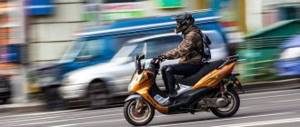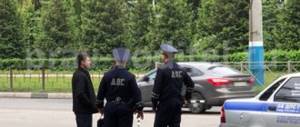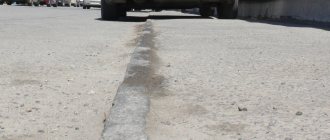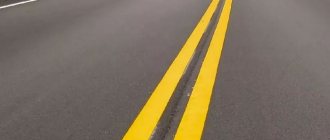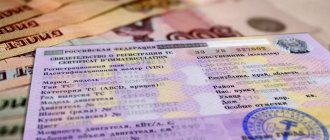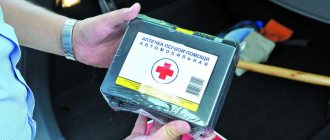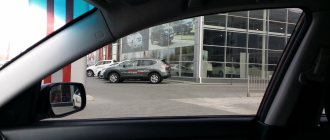The pedestrian is the “weak link”, the most unprotected participant in the movement. In order to ensure the safety of those who move without using vehicles, roadways are equipped with special communications: sidewalks.
Dear readers! The article talks about typical ways to resolve legal issues, but each case is individual. If you want to find out how to solve your particular problem , contact a consultant:
+7 (499) 938-81-90 (Moscow)
+7 (812) 467-32-77 (Saint Petersburg)
8 (800) 301-79-36 (Regions)
APPLICATIONS AND CALLS ARE ACCEPTED 24/7 and 7 days a week.
It's fast and FREE !
However, some drivers, disregarding the law, allow themselves to drive onto these structures, interfering with the movement of people, and sometimes creating a threat to their health and life.
Definition
For greater clarity, let's first review some basic terms:
- A road is a strip of land adapted for the passage of vehicles, which consists of elements such as carriageways (one or more), tram rails, shoulders, dividing structures and sidewalks.
- A sidewalk is a part of the road adjacent to the roadway, specially created for the movement of pedestrians. This engineering structure is separated from the main road by a concrete curb or narrow lawn.
- The shoulder is an integral part of the road, which differs from the main road surface in the type of coating or is separated from it by specially applied markings 1.2.
- Pedestrian path is a strip or surface of one of the artificial engineering objects (bridge, overpass) created for walking, which is not in contact with the roadway.
- Parking is a place adjacent to the curb, roadway or sidewalk, which is intended for parking mechanical vehicles.
The curb differs from the sidewalk in that it is always on the same level as the road surface for cars and is never separated from it by a lawn.
Sidewalks can have asphalt, concrete, or wood surfaces. They are located on the sides of streets where transport is carried out. Most often, the structure is slightly raised above the other elements of the road.
Who else besides motorists is prohibited from driving along this section of the road?
In addition to drivers of private cars, driving on sidewalks is prohibited:
- drivers of two-wheeled vehicles whose maximum speed does not exceed 50 km/h (this is the maximum for mopeds and scooters), provided that there is a bicycle path or the right edge of the roadway or shoulder is accessible for riding. If there are no other places for movement, then you can use the path for pedestrians;
- motorcyclists. They are only allowed to ride on the roadway, since a motorcycle is not a slow-moving vehicle.
Drivers often commit violations because they confuse the sidewalk and the curb. The roadside can be recognized by the following signs:
- Not separated from the roadway, adjacent to it and located on the same level. The sidewalk part, as a rule, is located slightly higher than the road surface for cars and the side of the road.
- Pedestrians are not allowed to move along it, as it is needed for cars to leave the road and make unexpected stops.
- It has a surface and markings that are different from the roadway (for example, it may not have asphalt). Pedestrians should remember that the shoulder is not intended for walking.
What should be the minimum and maximum width?
On the territory of our country there are special SNiPs and state standards that contain geometric standards for road structures.
According to GOST 52766-2007 (clause 4.5.1.1), the presence of a sidewalk is mandatory in those areas that run through any populated area.
The number of walking lanes is related to the intensity of the flow of people:
| with a total (in both directions) pedestrian traffic intensity of up to 50 people per hour | one lane allowed |
| at an intensity from 50 to 1000 people/hour | the sidewalk must consist of at least two lanes |
| when the number of pedestrians is more than 1000 in 1 hour | the number of stripes increases by one for every thousand |
The smallest permissible width of both the sidewalk and the pedestrian path for single-lane traffic is 1 meter. With a larger number of stripes, it should be more than 0.75 meters. The maximum width is not established by this GOST.
According to the standard, which, unfortunately, is often neglected by road services, in cities along the sidewalk it is necessary:
- install protective fencing in the form of metal structures;
- plant a “hedge” of shrubs up to 0.8 meters high.
The concept of sidewalk in accordance with traffic regulations
The definition of the concept “sidewalk” is given in clause 1.2 of the traffic rules, where this section of the road means an area adjacent to the road, equipped for pedestrian traffic. A pedestrian path (sidewalk) can be separated from the road by a decorative area (lawn).
This concept is not identical to the term “roadside”. According to road rules, a shoulder is understood as a structural part of the road surface that lies in the same plane as the road, without elevation, but differs from it in the type of coating (embankment, crushed stone). The stopping strip of the roadside is reinforced with various materials - bitumen-mineral mixtures, asphalt concrete, crushed stone pavement. The side of the road is marked with special markings 1.2.1, 1.2.2.
It should be remembered that it is an administrative violation to park a car on the sidewalk, and not on the side of the road. A distinctive feature of the sidewalk is the presence of a dividing element. If the lane is directly adjacent to the road, it is a shoulder (you cannot drive on it, but you can park the vehicle).
Driving on the sidewalk is considered in the administrative code as an independent type of offense with more serious sanctions.
Sidewalk signs
The traffic regulations do not provide for special graphic symbols identifying the sidewalk. Pedestrian paths are indicated by object 4.5.1, the appearance of which is shown in the photo below.
Often the installed symbol has two purposes at once, indicating both a sector for pedestrians and a path for bicycle traffic. In the case of this combination, it looks a little different.
If the movement of people and cyclists is separate, such a road structure is indicated by a special object shown in the following photo.
Lane width on the road
Often, many traffic violations and accidents are not the fault of drivers, but due to the narrow width or small number of lanes on the road. Thus, road signs or traffic lights are often obscured by branches or architecture, and because of potholes on the highway, motorists are forced to go around potholes and drive from one lane of the road to another.
You can also reduce your guilt or completely “amnesty” it if you drove into the oncoming lane while performing a maneuver, and the width of the lane itself turned out to be too small. Simply put, the road workers decided to save money and made a too narrow road instead of a wide one.
What is allowed and what is prohibited for vehicles
Any driver driving a car must understand that driving onto those elements of the road structure that are intended for people to walk and cyclists to move means, at the very least, disrespect for other participants.
You cannot be irresponsible about the safety of others by driving around, for example, a traffic jam or the scene of an accident on the sidewalk.
In addition, it is not uncommon for a car to have damaged rims or tires after overcoming a high curb.
City infrastructure is not always so well developed that the likelihood of traffic jams is minimized, but law and safety cannot be neglected in any case.
Movement
Traffic regulations do not allow driving a car on sidewalks, pedestrian and bicycle sectors of the road (clause 9.9). Only mopeds are allowed in the bicycle lane.
In the absence of other options, the following may enter the specified objects:
- equipment of municipal or road maintenance organizations;
- cars delivering goods to stores;
- vehicles that delivered goods to enterprises (facilities) located at the curb or sidewalk.
Upon arrival, the driver is obliged to ensure complete safety of his maneuver for people. This means that he first needs to get out of the car and make sure that there are no approaching pedestrians, and if there are any, he needs to warn them of his intention.
You should wait until people have moved away to a safe distance, and only then can you carefully begin the race.
What traffic rules apply for motorcyclists in 2021 is stated in the article: Traffic rules for motorcyclists. Read what the term “give way” means in the traffic rules here.
Parking or parking
Stopping or parking on sidewalks and pedestrian paths is also prohibited by current legislation.
On the edge of the sidewalk adjacent to the roadway, you can only park:
- a car;
- motorbike;
- moped.
In this case, such a place must be marked with a special symbol (6.4) and a corresponding sign showing the method of placing vehicles.
Loading and unloading
A personal car is often used to transport large household appliances, furniture, and building materials. In this case, the problem of carrying heavy loads from the porch of the store to the trunk of the car often arises.
If the driver decides to drive onto the sidewalk adjacent to a retail facility, he will commit an offense. Here there is a gap in the traffic rules, since they only regulate the delivery of goods.
According to the law, the delivery driver has the right to enter the pedestrian sector of the road if he needs to hand over the delivered goods ordered by the store management.
However, in practice, inspectors still draw up protocols in such cases and issue decisions on imposing fines.
If a person appeals such a document in court, within the ten-day period and presenting documentary evidence that he actually unloaded the goods, he has a chance to avoid punishment.
Riding a bicycle, motorcycle or moped
Children under 7 years of age may ride a bicycle only on sidewalks or sections of bicycle and pedestrian paths intended for walking.
Persons over 14 years of age are allowed to drive on these engineering facilities if:
- the road is not equipped with a special sector for bicycles, or the road surface is damaged, which makes movement impossible;
- the cyclist is transporting a child under 7 years of age or accompanying a second cyclist who is under 14 years of age.
Here, as we see, the situation is the opposite: for the safety of children, they are prohibited from moving along the main road.
If a child leaves the roadway, his parents or legal representative will be held accountable; such protocols are reviewed by commissions on juvenile affairs.
In this case, the same prohibitions apply for motorcyclists as for persons driving cars and other four-wheeled vehicles.
Parking here is also possible:
- in specially designated places;
- on the right side of the road, and if there is none, on the edge of the roadway.
The only difference is that if motorcycles do not have side trailers (“cradles”), then they can be arranged in two rows, and not in one.
A moped driver can ride on a bicycle path, even if he has the opportunity to move directly along the roadway. It is absolutely forbidden to drive onto the sidewalk, as well as onto the pedestrian path.
Riding a bicycle on the sidewalk
The movement of cyclists along sections of the road is regulated by clause 24 of the traffic rules. Depending on the age category, the following conditions apply:
- children under 7 years of age can ride a bicycle only on the sidewalk or pedestrian path (including bicycle and pedestrian paths), in pedestrian areas;
- for citizens of the age group from 7 to 14 years old, the rule applies to driving within the pedestrian zone, on the sidewalk or on a road lane designated for cyclists;
- persons over 14 years of age may ride a bicycle only on specially designated sections of the road or on the right edge of the roadway.
View more articles from the category: Traffic Rules
Did you like the article? Share with friends:
What are the penalties for violations?
The amount of the penalty will depend on whether the car is moving or parked:
| Punishment for moving by mechanical transport along parts of road communications intended only for walking is provided for in Part 2 of Art. 12.15 Code of Administrative Offenses of the Russian Federation | Such an act will entail a fine for the driver, the amount of which will be 2000 rubles. |
| Stopping a vehicle on the sidewalk or parking it is punishable in accordance with Part 3 of Art. 12.19 Code of Administrative Offenses of the Russian Federation | For such a violation, a decision will be issued imposing a fine of 1,000 rubles. |
| The same violation committed on the territory of the capital or St. Petersburg | Will entail the imposition of a more severe fine - 3,000 rubles |
If the violator meets the deadline within 20 days, he has the right to a kind of “discount” in the form of payment of half the assigned amount. This period is calculated from the date of the decision, and not from the moment the document gains legal force, as many believe.
As with any other administrative fine, failure to pay it within 60 days will be punishable by double the amount, mandatory work, or arrest.
The most unpleasant consequence of driving onto the sidewalk may be the evacuation of the car to a specialized parking lot.
By not complying with the law, the driver runs the risk of not finding his vehicle in the place where he left it. In addition, he will also have to pay for the services of a tow truck and storage of the car itself.
If a person discovers that his car has been towed, he should:
- call the police and make sure that this is not a theft, but really an administrative measure;
- find out the name of the inspector who issued the detention, as well as the address of the parking lot to which the car was transported;
If all the documents are left inside, you will first have to drive to the parking lot. The employee will formalize the opening procedure and remove the seal on the driver's door, after which you can pick up the documents and go to the traffic police.
If you have a driver’s license and registration certificate in hand, you need to immediately contact the police.
Some vehicle owners have the habit of leaving a note under the glass with a phone number by which they can be contacted if a similar situation arises.
However, you should not count on the towing service workers to call the owner and warn him that the car has been taken away. These people are interested in the driver paying for moving and ensuring the safety of the vehicle.
The conclusion from the above is simple: the desire to get there quickly, while breaking the law, may ultimately result in the cost of paying a fine issued by the inspector.
It is necessary to understand once and for all that appealing a decision is difficult and time-consuming; it is much easier to avoid its issuance by observing the current rules when driving.
Driving in a bus lane in traffic regulations is discussed in the article: bus lane in traffic regulations. Where to put the “novice driver” sign according to the traffic rules, see on the page.
Learn about avoiding obstacles from this information.
Punishment for the driver for violation
Driving on the sidewalk is an administrative offense. This action is punishable by a fine of 2,000 rubles. Those who drive on pedestrian paths face the same fine.
For stopping or parking on the sidewalk (and therefore for interfering with pedestrians), a motorist will be fined 500 rubles. For violation of parking rules, the car can be towed and taken to the impound lot.
| Did not find an answer to your question? Call a lawyer! Moscow: +7 (499) 110-89-42 St. Petersburg: +7 (812) 385-56-34 Russia: +7 (499) 755-96-84 |
If a pedestrian is injured as a result of the driver driving along the sidewalk, the proceedings will go to court. Pedestrians are always right on the sidewalk, since this area of the road is intended specifically for them.


